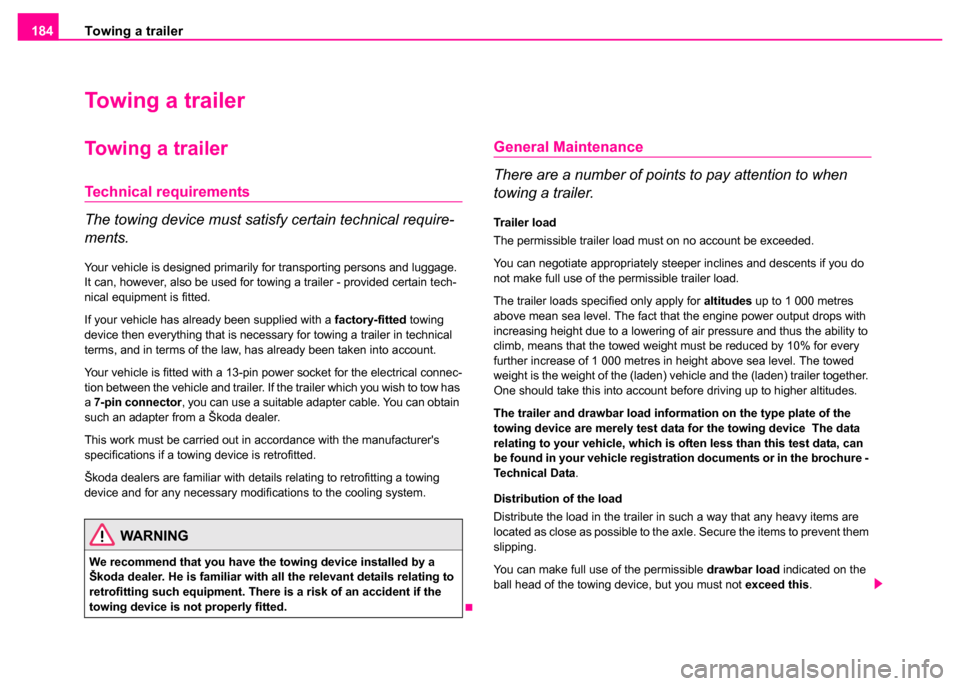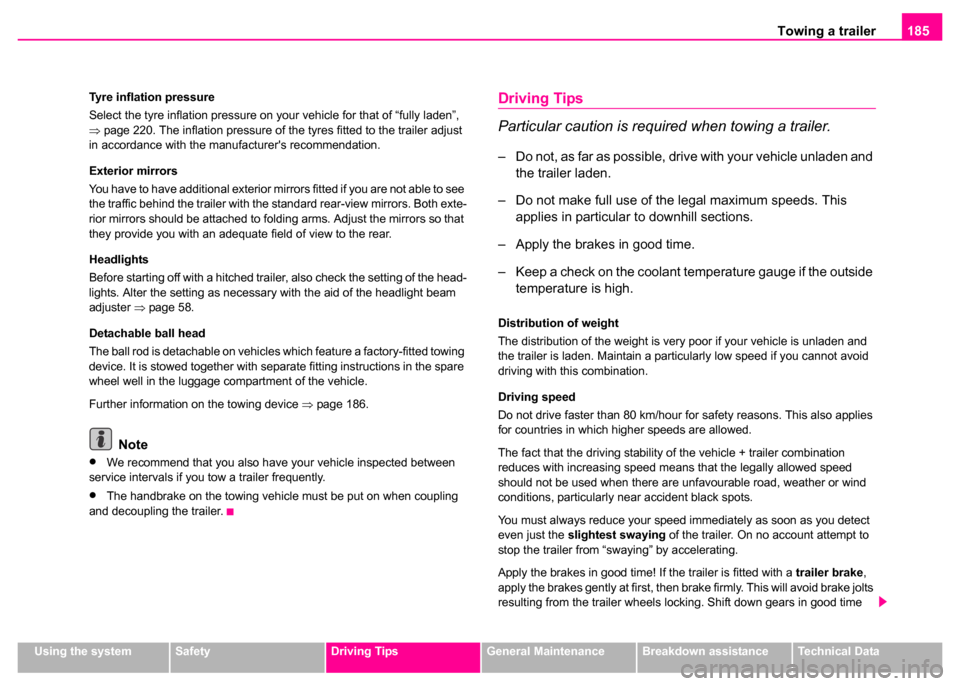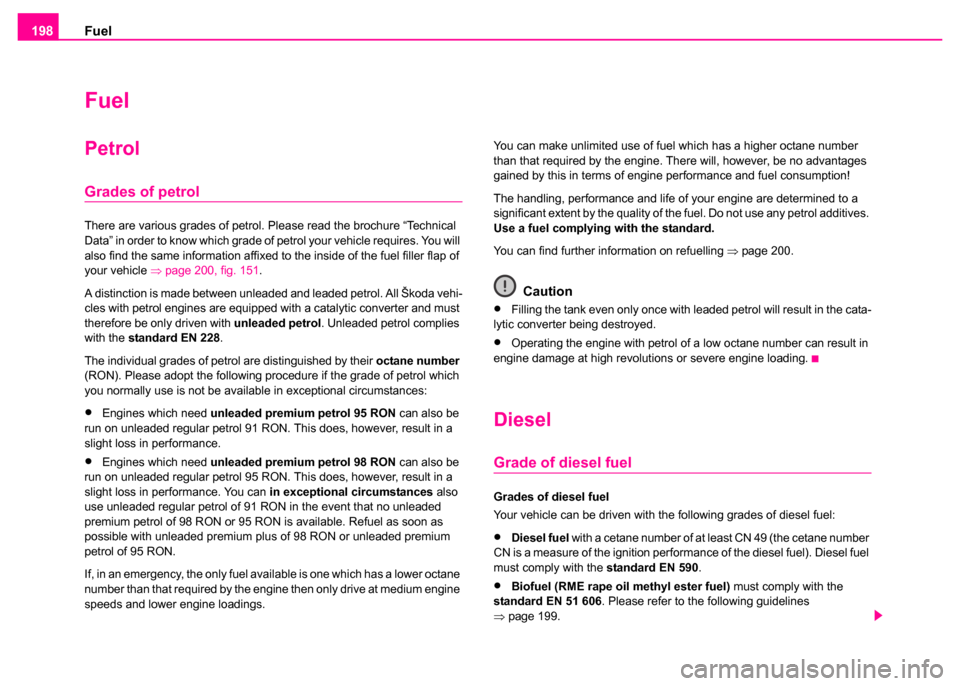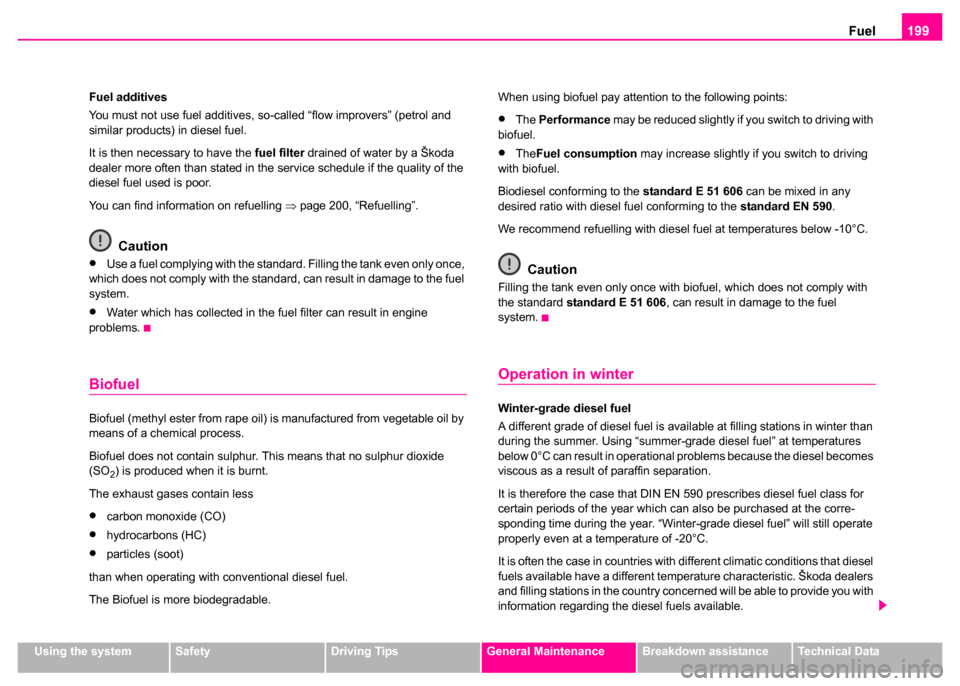technical data SKODA SUPERB 2003 1.G / (B5/3U) Owners Manual
[x] Cancel search | Manufacturer: SKODA, Model Year: 2003, Model line: SUPERB, Model: SKODA SUPERB 2003 1.G / (B5/3U)Pages: 259
Page 185 of 259

Towing a trailer
184
Towing a trailer
Towing a trailer
Technical requirements
The towing device must satisfy certain technical require-
ments.
Your vehicle is designed primarily for transporting persons and luggage.
It can, however, also be used for towing a trailer - provided certain tech-
nical equipment is fitted.
If your vehicle has already been supplied with a factory-fitted towing
device then everything that is necessary for towing a trailer in technical
terms, and in terms of the law, has already been taken into account.
Your vehicle is fitted with a 13-pin power socket for the electrical connec-
tion between the vehicle and trailer. If the trailer which you wish to tow has
a 7-pin connector , you can use a suitable adapter cable. You can obtain
such an adapter from a Škoda dealer.
This work must be carried out in accordance with the manufacturer's
specifications if a towing device is retrofitted.
Škoda dealers are familiar with details relating to retrofitting a towing
device and for any necessary modifications to the cooling system.
General Maintenance
There are a number of points to pay attention to when
towing a trailer.
Trailer load
The permissible trailer load must on no account be exceeded.
You can negotiate appropriately steeper inclines and descents if you do
not make full use of the permissible trailer load.
The trailer loads specified only apply for altitudes up to 1 000 metres
above mean sea level. The fact that the engine power output drops with
increasing height due to a lowering of air pressure and thus the ability to
climb, means that the towed weight must be reduced by 10% for every
further increase of 1 000 metres in height above sea level. The towed
weight is the weight of the (laden) vehicle and the (laden) trailer together.
One should take this into account before driving up to higher altitudes.
The trailer and drawbar load information on the type plate of the
towing device are merely test data for the towing device The data
relating to your vehicle, which is often less than this test data, can
be found in your vehicle registration documents or in the brochure -
Technical Data.
Distribution of the load
Distribute the load in the trailer in such a way that any heavy items are
located as close as possible to the axle. Secure the items to prevent them
slipping.
You can make full use of the permissible drawbar load indicated on the
ball head of the towing device, but you must not exceed this.
WARNING
We recommend that you have the towing device installed by a
Škoda dealer. He is familiar with all the relevant details relating to
retrofitting such equipment. There is a risk of an accident if the
towing device is not properly fitted.
Page 186 of 259

Towing a trailer185
Using the systemSafetyDriving TipsGeneral MaintenanceBreakdown assistanceTechnical Data
Tyre inflation pressure
Select the tyre inflation pressure on your vehicle for that of “fully laden”,
⇒
page 220. The inflation pressure of the tyres fitted to the trailer adjust
in accordance with the manufacturer's recommendation.
Exterior mirrors
You have to have additional exterior mirrors fitted if you are not able to see
the traffic behind the trailer with the standard rear-view mirrors. Both exte-
rior mirrors should be attached to folding arms. Adjust the mirrors so that
they provide you with an adequate field of view to the rear.
Headlights
Before starting off with a hitched trailer, also check the setting of the head-
lights. Alter the setting as necessary with the aid of the headlight beam
adjuster ⇒page 58.
Detachable ball head
The ball rod is detachable on vehicles which feature a factory-fitted towing
device. It is stowed together with separate fitting instructions in the spare
wheel well in the luggage compartment of the vehicle.
Further information on the towing device ⇒page 186.
Note
•We recommend that you also have your vehicle inspected between
service intervals if you tow a trailer frequently.
•The handbrake on the towing vehicle must be put on when coupling
and decoupling the trailer.
Driving Tips
Particular caution is required when towing a trailer.
– Do not, as far as possible, drive with your vehicle unladen and the trailer laden.
– Do not make full use of the legal maximum speeds. This applies in particular to downhill sections.
– Apply the brakes in good time.
– Keep a check on the coolant temperature gauge if the outside temperature is high.
Distribution of weight
The distribution of the weight is very poor if your vehicle is unladen and
the trailer is laden. Maintain a particularly low speed if you cannot avoid
driving with this combination.
Driving speed
Do not drive faster than 80 km/hour for safety reasons. This also applies
for countries in which higher speeds are allowed.
The fact that the driving stability of the vehicle + trailer combination
reduces with increasing speed means that the legally allowed speed
should not be used when there are unfavourable road, weather or wind
conditions, particularly near accident black spots.
You must always reduce your speed immediately as soon as you detect
even just the slightest swaying of the trailer. On no account attempt to
stop the trailer from “swaying” by accelerating.
Apply the brakes in good time! If the trailer is fitted with a trailer brake,
apply the brakes gently at first, then brake firmly. This will avoid brake jolts
resulting from the trailer wheels locking. Shift down gears in good time
Page 188 of 259

Towing a trailer187
Using the systemSafetyDriving TipsGeneral MaintenanceBreakdown assistanceTechnical Data
•Contact a Škoda dealer if you encounter any problems using the
device.
•Inspect the ball head to ensure that it is properly locked each time
before setting off.
•Never unlock the ball head with a trailer coupled to it.
•You should take off the ball head if you drive without towing a trailer.
Inspect whether the end cover properly seals off the mounting shaft.
•Remove the ball head beforehand if you wish to clean your vehicle
using a steam jet. Ensure that the end cover properly seals the mounting
shaft.
Page 190 of 259

Care and cleaning189
Using the systemSafetyDriving TipsGeneral MaintenanceBreakdown assistanceTechnical Data
General Maintenance
Care and cleaning
General
Proper care retains the value of your vehicle.
Regular and proper care retains the value of your vehicle. It may also be
one of the requirements for the acceptance of warranty claims relating to
corrosion damage and paint defects on the bodywork.
You can obtain the necessary care products from Škoda dealers. Please
follow the instructions for use on the package.
For the sake of the environment
•Always select environmentally-friendly products when purchasing
vehicle care products.
•Do not dispose of residues of care products in domestic waste.
Care of the exterior of vehicle
Washing the vehicle
Frequent washing protects your vehicle.
The best protection for your vehicle against harmful environmental influ-
ences is frequent washing and wax treatment. How often you should
wash your vehicle depends on a wide range of factors, such as:
•Frequency of use
•The parking situation (garage, below trees etc.)
•Season of the year
•Weather conditions
•Environmental influences
The longer insect residues, bird droppings, tree sap, road and industrial
dust, tar, soot particles, road salt and other aggressive deposits remain
adhering to the paintwork of your vehicle, the more detrimental their
destructive effect can be. High temperatures, such as those caused by
intensive sun's rays, accentuate this caustic effect.
It may therefore be necessary, in certain circumstances, to wash the car
once a week. It may also be sufficient, however, to wash the car once a
month followed by appropriate wax treatment.
It is essential to also thoroughly wash the underside of your vehicle at
the end of the winter road salting and gritting period.
WARNING
•Care products may be harmful to your health if not used
according to the instructions.
•Always store care products in a safe place, out of the reach of
children - risk of poisoning!
Page 192 of 259

Care and cleaning191
Using the systemSafetyDriving TipsGeneral MaintenanceBreakdown assistanceTechnical Data
For the sake of the environment
Only wash your vehicle at washing bays specifically reserved for this
purpose. This ensures that no water which may be contaminated by oil
flows into the sewage system. It is not even permitted to wash your vehicle
in certain areas except at such specific washing bays.
Washing with a high-pressure cleaner
When you wash your vehicle with a high-pressure cleaner, it is essential
to comply with the instructions for use of the cleaning equipment. This
applies in particular to the pressure used and to the spraying distance .
Maintain a sufficiently large distance to soft materials such as rubber
hoses or insulation material.
On no account use circular spray nozzles or so-called dirt cutters .
The water containing wax must be no hotter than 60°C.
Caution
It is particularly important that you do not clean tyres with circular spray
jets. Damage to tyres may occur even at a relatively large spraying
distance and if sprayed only for a short time.
Wax treatment
Good wax treatment is an effective way of protecting the paintwork from
harmful environmental influences and minor mechanical damage.
A new layer of a high-quality hard wax polish can be applied to the clean
bodywork after it has dried thoroughly. Even if you use a wax preserver regularly we still recommend that you treat the paintwork of the vehicle at
least twice a year with hard wax.
Caution
Never apply wax to the windows.
Polishing
Polishing is only necessary if the paintwork of your vehicle has become
unattractive and if it is no longer possible to achieve a gloss with wax
preservers.
You must treat the paintwork with a wax preserver if the polish you use
does not contain any preserving elements
⇒page 191, “Wax treatment”.
We recommend using a preservative from the range of accessories
offered by your Skoda dealer.
Caution
You must not treat mat painted parts or plastic with polishing products or
hard wax.
Trim strips
Use pH neutral care products to remove stains and coatings on trim
strips - in other words not chrome care products. Škoda Dealers have
available a range of environmentally compatible cleaning products which
have been tested and approved for your car.
Page 194 of 259

Care and cleaning193
Using the systemSafetyDriving TipsGeneral MaintenanceBreakdown assistanceTechnical Data
of the seals and prevent leakages in this way. It is also easier to open the
doors. Rubber seals which are well cared for also do not stick together in
cold winter weather.
Locks
We recommend that you use Genuine Škoda Spray with regreasing and
anticorrosive effect for de-icing locks.
Note
When washing your vehicle, ensure that as little water as possible gets
into the locks.
Wheels
Steel wheels
You should also thoroughly wash the wheels and wheel trims when giving
your vehicle its regular wash. This prevents any brake dust, dirt and road
salt from sticking to the wheel hubs. You can remove stubborn brake abra-
sion adhering to the wheels with an industrial cleaner. Touch up any
damage to the paintwork on the wheels before rust is able to form.
Light alloy wheels
Regular care of light alloy wheels is necessary in order to retain their
decorative appearance over long periods. It is particularly important to
remove any road salt and brake abrasion from light alloy wheels every two
weeks, otherwise the surface will suffer. Wash thoroughly and then treat
the wheels with a protective product for light alloy wheels which does not
contain any acidic components. You should provide the wheel hubs with
a hard wax layer every three months. You must not use any products
which cause abrasion when treating the wheel hubs. Any damage to the
paint layer on the wheel hubs must be touched up immediately.
We recommend using a preservative from the range of accessories
offered by your Skoda dealer.
Note
Severe layers of dirt on the wheels can also result in wheel imbalance.
This may show itself in the form of wheel vibration which is transmitted to
the steering wheel which, in certain circumstances, can cause premature
wear of the steering. It is therefore important to clean dirty wheels.
Underbody protection
The underside of your vehicle is protected for life against chemical and
mechanical influences.
One cannot, however, completely rule out damage to the
protective layer
when driving so we recommend that you inspect the protective layer on
the underside of your vehicle and on the chassis at certain intervals - this
is best done at the beginning and end of the winter - and to touch up any
damaged areas.
Škoda dealers have suitable spray products available as well as the
necessary equipment and are familiar with the instructions for its use. It is
therefore best to have such touch-up work or additional corrosion protec-
tion measures carried out by a Škoda dealer.
WARNING
One should remember when cleaning the wheels that moisture, ice
and road salt may adversely affect braking efficiency - risk of an
accident!
Page 196 of 259

Care and cleaning195
Using the systemSafetyDriving TipsGeneral MaintenanceBreakdown assistanceTechnical Data
Leather cleaning and care
In view of the exclusiveness of the qualities and characteristics of the
leathers used (such as sensitivity to oils, greases, dirt etc.) a certain care-
fulness in use and particular care are required. Dark items of clothing, for
example, (particularly if these are moist and have poor quality dyeing)
may colour the leather seats. Dust and dirt particles in pores, creases and
seams may chafe and damage the surface. For this reason, care for the
leather regularly, or according to the wear-and-tear. After a lengthy period
of use, your leather seats will acquire a typical and unique patina. This is
characteristic of the natural product leather and is a sign of genuine
quality.
Please pay attention to the following notes in order to retain the value of
the natural material over its full life:
Caution
•Avoid leaving your vehicle for lengthy periods in bright sunlight in order
to avoid bleaching the leather. If you leave your vehicle parked in the open
for lengthy periods, protect the leather from the direct rays of the sun by
covering it over.
•Sharp-edged objects on items of clothing such as zip fasteners, rivets,
sharp-edged belts may leave permanent scratches or signs of rubbing on
the surface.
Note
•Use a care cream with light blocker and impregnation effect regularly
and each time after cleaning the leather. The cream nourishes the leather,
allows it to breathe and keeps it supple and also provides moisture. It also
creates surface protection.
•Clean the leather every 2 to 3 months, remove fresh soiling each time
this occurs.
•Remove fresh stains such as those from ball-point pens, ink, lipstick,
shoe cream etc., as quickly as possible.
•Care also for the leather dye. Refreshen areas which have lost their
colour with a special coloured leather cream as required.
Cleaning and care of leather upholstery
Normal cleaning
– Clean soiled areas of the leather with slightly moistened
cotton or woollen cloth.
Severe soiling
– Clean severely soiled areas with a cloth dipped in a mild soapy solution (2 spoonfuls of natural soap to 1 litre of water).
– Ensure that the leather is not soaked through at any point and that no water gets into the stitching of the seams.
– Dry off the leather with a soft, dry cloth.
Removing stains
– Remove fresh stains which are water-based (e.g. coffee, tea,
juices, blood etc.) with an absorbent cloth or household paper
or use the cleaner from the care set for a stain which has
already dried in.
– Remove fresh stains which are oil based (e.g. butter, mayon-
naise, chocolate etc.) with an absorbent cloth or household
cleaning paper or with the cleaner from the care set if the stain
has not yet penetrated into the surface.
– Use a grease dissolver for grease stains which have dried
in .
Page 198 of 259

Care and cleaning197
Using the systemSafetyDriving TipsGeneral MaintenanceBreakdown assistanceTechnical Data
Skoda dealers have the cleaning agents and preservatives recommended
by the manufacturer and also the required equipment.
Caution
•Engine cleaning may be only be undertaken when the ignition is off.
•It is recommended to cover the generator before washing the engine
compartment.
For the sake of the environment
The dirty water produced by washing the engine has washed away petrol,
and residues of grease and oil and should therefore be cleaned by an oil
separator. This is why engine washing should only be undertaken in a
garage or at a fueling station (when these are fitted with the required
equipment).
WARNING
It is necessary to observe the guidelines given in the chapter
before working on the engine compartment ⇒page 203.
Page 199 of 259

Fuel
198
Fuel
Petrol
Grades of petrol
There are various grades of petrol. Please read the brochure “Technical
Data” in order to know which grade of petrol your vehicle requires. You will
also find the same information affixed to the inside of the fuel filler flap of
your vehicle ⇒page 200, fig. 151 .
A distinction is made between unleaded and leaded petrol. All Škoda vehi-
cles with petrol engines are equipped with a catalytic converter and must
therefore be only driven with unleaded petrol. Unleaded petrol complies
with the standard EN 228 .
The individual grades of petrol are distinguished by their octane number
(RON). Please adopt the following procedure if the grade of petrol which
you normally use is not be available in exceptional circumstances:
•Engines which need unleaded premium petrol 95 RON can also be
run on unleaded regular petrol 91 RON. This does, however, result in a
slight loss in performance.
•Engines which need unleaded premium petrol 98 RON can also be
run on unleaded regular petrol 95 RON. This does, however, result in a
slight loss in performance. You can in exceptional circumstances also
use unleaded regular petrol of 91 RON in the event that no unleaded
premium petrol of 98 RON or 95 RON is available. Refuel as soon as
possible with unleaded premium plus of 98 RON or unleaded premium
petrol of 95 RON.
If, in an emergency, the only fuel available is one which has a lower octane
number than that required by the engine then only drive at medium engine
speeds and lower engine loadings. You can make unlimited use of fuel which has a higher octane number
than that required by the engine. There will, however, be no advantages
gained by this in terms of engine performance and fuel consumption!
The handling, performance and life of your engine are determined to a
significant extent by the quality of the fuel. Do not use any petrol additives.
Use a fuel complying with the standard.
You can find further information on refuelling
⇒page 200.
Caution
•Filling the tank even only once with leaded petrol will result in the cata-
lytic converter being destroyed.
•Operating the engine with petrol of a low octane number can result in
engine damage at high revolutions or severe engine loading.
Diesel
Grade of diesel fuel
Grades of diesel fuel
Your vehicle can be driven with the following grades of diesel fuel:
•Diesel fuel with a cetane number of at least CN 49 (the cetane number
CN is a measure of the ignition performance of the diesel fuel). Diesel fuel
must comply with the standard EN 590 .
•Biofuel (RME rape oil methyl ester fuel) must comply with the
standard EN 51 606 . Please refer to the following guidelines
⇒ page 199.
Page 200 of 259

Fuel199
Using the systemSafetyDriving TipsGeneral MaintenanceBreakdown assistanceTechnical Data
Fuel additives
You must not use fuel additives, so-called “flow improvers” (petrol and
similar products) in diesel fuel.
It is then necessary to have the
fuel filter drained of water by a Škoda
dealer more often than stated in the service schedule if the quality of the
diesel fuel used is poor.
You can find information on refuelling ⇒page 200, “Refuelling”.
Caution
•Use a fuel complying with the standard. Filling the tank even only once,
which does not comply with the standard, can result in damage to the fuel
system.
•Water which has collected in the fuel filter can result in engine
problems.
Biofuel
Biofuel (methyl ester from rape oil) is manufactured from vegetable oil by
means of a chemical process.
Biofuel does not contain sulphur. This means that no sulphur dioxide
(SO
2) is produced when it is burnt.
The exhaust gases contain less
•carbon monoxide (CO)
•hydrocarbons (HC)
•particles (soot)
than when operating with conventional diesel fuel.
The Biofuel is more biodegradable. When using biofuel pay attention to the following points:
•The
Performance may be reduced slightly if you switch to driving with
biofuel.
•The Fuel consumption may increase slightly if you switch to driving
with biofuel.
Biodiesel conforming to the standard E 51 606 can be mixed in any
desired ratio with diesel fuel conforming to the standard EN 590.
We recommend refuelling with diesel fuel at temperatures below -10°C.
Caution
Filling the tank even only once with biofuel, which does not comply with
the standard standard E 51 606 , can result in damage to the fuel
system.
Operation in winter
Winter-grade diesel fuel
A different grade of diesel fuel is available at filling stations in winter than
during the summer. Using “summer-grade diesel fuel” at temperatures
below 0°C can result in operational problems because the diesel becomes
viscous as a result of paraffin separation.
It is therefore the case that DIN EN 590 prescribes diesel fuel class for
certain periods of the year which can also be purchased at the corre-
sponding time during the year. “Winter-grade diesel fuel” will still operate
properly even at a temperature of -20°C.
It is often the case in countries with different climatic conditions that diesel
fuels available have a different temperature characteristic. Škoda dealers
and filling stations in the country concerned will be able to provide you with
information regarding the diesel fuels available.